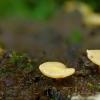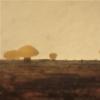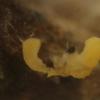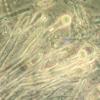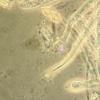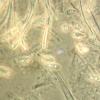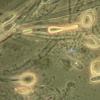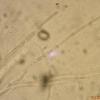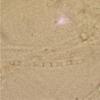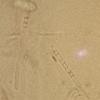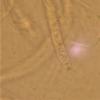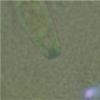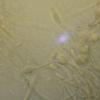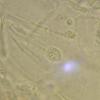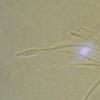
15-12-2025 15:48
 Danny Newman
Danny Newman
Melanospora cf. lagenaria on old, rotting, fallen

15-12-2025 15:54
 Johan Boonefaes
Johan Boonefaes
Unknown anamorph found on the ground in coastal sa

15-12-2025 21:11
 Hardware Tony
Hardware Tony
Small clavate hairs, negative croziers and IKI bb

15-12-2025 07:09
 Danny Newman
Danny Newman
indet. Rutstroemiaceae sp. on unk. fallen leavesMc

15-12-2025 07:05
 Danny Newman
Danny Newman
Pseudosclerococcum golindoi (det: Zotto)near Cosb

15-12-2025 11:49
 Danny Newman
Danny Newman
ITS sequences from the following two collections B

15-12-2025 12:34
 Danny Newman
Danny Newman
indet. Rhytismataceae on oak leafnear Purchase Roa

09-12-2025 12:06
 Andgelo Mombert
Andgelo Mombert
Bonjour,Je recherche l'article concernant Hypobryo
Hymenoscyphus (?) with balloon-like inflated paraphyses
Edvin Johannesen,
10-10-2020 14:34
 This was found in a moist ravine on (probably) Ulmus twig. The base of the stalks are conspicuously black, the hymenium is convex. Ectal excipulum consisting of more or less spherical cells. Spores measure ca. 11-12 x 5 microns, with two polar guttules (in water) or a few, non-septate. Throughout the hymenium are highly inflated "paraphyses", looking like "lanterns" mostly half-filled with some "oily" substance. Asci without croziers. Ascus pore staining blue in Lugol after pre-treatment with KOH and washing. Suggestions appreciated.
This was found in a moist ravine on (probably) Ulmus twig. The base of the stalks are conspicuously black, the hymenium is convex. Ectal excipulum consisting of more or less spherical cells. Spores measure ca. 11-12 x 5 microns, with two polar guttules (in water) or a few, non-septate. Throughout the hymenium are highly inflated "paraphyses", looking like "lanterns" mostly half-filled with some "oily" substance. Asci without croziers. Ascus pore staining blue in Lugol after pre-treatment with KOH and washing. Suggestions appreciated.
Edvin Johannesen,
10-10-2020 14:36
Edvin Johannesen,
10-10-2020 14:37
Edvin Johannesen,
10-10-2020 14:37
Hans-Otto Baral,
10-10-2020 16:15

Re : Hymenoscyphus (?) with balloon-like inflated paraphyses
I guess the onflated structures are germinating spores growing with their tubes into the hymenium.
An ascus apical ring would be necessary to clarify the genus, also living paraphyses.
Edvin Johannesen,
10-10-2020 17:18

Re : Hymenoscyphus (?) with balloon-like inflated paraphyses
Thanks for the comments. I have now tried to image the "normal" paraphyses, which are multiguttulate. They should be alive since it's from a fresh specimen and mounted in water. Regarding the inflated structures, I am in doubt whether they are germinating spores. First of all they seem to form a "palisade" in the hymenium (photo). Secondly, the "hyphae" emerging from them are very much like the paraphyses in structure (if have observed multiguttulate sections).
I have tried also to image the ascus ring, turning blue in Lugol (no pre-treatment this time). Sorry about the poor image quality - I don't have access to fancy imaging equipment, unfortunately.
Hans-Otto Baral,
10-10-2020 17:41

Re : Hymenoscyphus (?) with balloon-like inflated paraphyses
The ring suggests Calycina ("Bisporella") citrina. I feel there are lots of bacteria in the apothecia. Multiguttulate paraphyses I could not see.
Edvin Johannesen,
10-10-2020 18:11

Re : Hymenoscyphus (?) with balloon-like inflated paraphyses
The specimen is perfectly fresh - I do not see a lot of bacteria. The "dots" in the high magnification images is camera noise. Hard to find a good trade-off between resolution and contrast. If you don't see guttules in the paraphyses, I wonder what are the structures inside them?
Hans-Otto Baral,
10-10-2020 18:20

Re : Hymenoscyphus (?) with balloon-like inflated paraphyses
Sorry when I misinterpreted your pics. In the first pic of the last series are a few paraphyses, and it is clear to me that the lower cells (on the left are alive, but the terminal cells dead. They actually look granular, but for a taxonomic purpose we need living cells. Not every cell is alive when freshly mounted in water.
The lower cells contain non-refractive vacuoles.
Edvin Johannesen,
11-10-2020 13:44

Re : Hymenoscyphus (?) with balloon-like inflated paraphyses
Thanks again. I am struggling a bit with deciding what are living and dead cells in these inoperculates. Regarding the inflated structures, I notice some similarity to the paraphyses drawn (Fig. 3) in your 2015 paper on Calycina marina. Of course this is a totally different Calycina, but maybe the structures in my specimen are indeed paraphyses? I have studied Calycina citrina many times and to me this looked quite different, which is why I collected it. But you're the expert :)
Can you guide me to a good paper/key to distinguishing the various genera in the Helotiaceae (Calycina, Bisporella, Hymenoscyphus, Phaeohelotium etc.). I am a bit confused at the moment. Key to species would of course be welcome, too.
Cheers.
Hans-Otto Baral,
11-10-2020 16:15

Re : Hymenoscyphus (?) with balloon-like inflated paraphyses
You show a living ascus (6th pic) with mature spores which look like C. citrina. Bisporella s.str. has a Hymenoscyphus-type of apical ring, unlike C. citrina with Calycina-type.
If I would see living paraphysis terminal cells I could draw your attention to the content: multiguttulate in Bisporella s.str., an elongate refractive vacuole in Calycina.
With keys it is helpless. I think the sark stipe base is also not uncommon in C. citrina. Sometimes the species is found with only sparse apos. But this is only a suspicion.
The baloon-like elements are all taken with phase contrast which lowers the resolution. Are they sometimes septate? That would be typical of spores, but they are indeed very wide. To clarify this ypu should try a section with a razor blade and follow the hyphal cells down to the ascus base, if they are really growing up from there and attached to the subhymenium tissue.
Edvin Johannesen,
11-10-2020 22:04

Re : Hymenoscyphus (?) with balloon-like inflated paraphyses
I appreciate your time, Zotto - very useful information. The specimen is now partly dried, but I will do my best to make a thin section to study the swollen structures.
Edvin Johannesen,
12-10-2020 12:40

Re : Hymenoscyphus (?) with balloon-like inflated paraphyses
I have now made a thin section of another, perfectly fresh apothecium. I've gone through the entire hymenium and the inflated cells always go into (or rather emerges from) the subhymenium in parallel to the asci and "normal" paraphyses. I observe all transitions from filiform paraphyses to slightly swollen paraphyses to these heavily inflated structures, which eventually seem to end up with small guttules in the apical part, but with refractive lower part. I have not seen any of them being septate. I am quite convinced these are not germinating spores, but whether this a an abnormal C. citrina, I don't know.
Hans-Otto Baral,
12-10-2020 17:12

Re : Hymenoscyphus (?) with balloon-like inflated paraphyses
I must revise my first impression, they actually are paraphyses. Anyway, the terminal cells are not alove, I assume they are filled with VBs in the living state which retract on dying towards the wall. As there seem not many mature living asci, I consider these inflations for the time being as abnormal.
Edvin Johannesen,
12-10-2020 22:19

Re : Hymenoscyphus (?) with balloon-like inflated paraphyses
OK. Not unreasonable, given that there was plenty of C. citrina in the area. What I ask myself is why there are so many dead asci and paraphyses in fresh material mounted in water. But maybe that's normal. Thanks again for your time.
Hans-Otto Baral,
13-10-2020 07:43

Re : Hymenoscyphus (?) with balloon-like inflated paraphyses
Difficult to explain, possibly the weather conditions. Longer drought? Frost?

